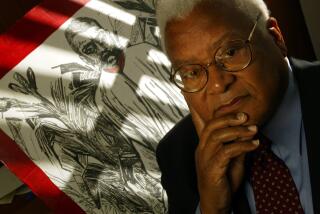The Maddox Legacy: ‘Phooey!’
- Share via
The last time I saw Lester Maddox was in 1978. He was on his hands and knees behind the counter of his gift shop in downtown Atlanta, using dishrags and towels to mop up 50 or so gallons of melted ice cream. As a journalist, I could not help but be transfixed by the sight of the former governor of Georgia reduced to such an ignominious task. Six months earlier, Maddox had suffered a near-fatal heart attack. During his convalescence, electricity had been shut off at his establishment. This occasion marked his first return visit, and he was intent on cleaning up, for he planned to be at the cash register that evening hawking such souvenirs as T-shirts emblazoned with his trademark epithet -- “Phooey!” -- and ax handles similar to those his supporters had used more than a decade before to chase black would-be diners from his famed Atlanta restaurant, the Pickrick.
My recollection of a frail but determined Maddox resurfaced late last month with the news of his death at the age of 87. So too did a related pang of guilt. I was with the former governor that long-ago day because I was reporting a piece for the Atlanta Journal & Constitution Magazine concerning his efforts to recover from a run of physical and financial problems. The publication of my story -- which included not just a description of the gooey mess that had greeted its subject at his shop but the fact that he earned a mere $35 the night he reopened -- prompted Maddox to fire off an angry letter accusing me of having written the nastiest article about him ever to appear in the Atlanta papers. This was an exaggeration, for the Journal and Constitution were so fiercely at war with Maddox during his term in office that he had ordered their racks removed from the Capitol grounds. Nonetheless, I had produced something hurtful to the former governor. He thought I portrayed him in an overly vulnerable position. Worse, he believed I did so in a spirit of ridicule.
To the charge that I somehow intruded on Maddox in what should have remained a private moment, I pleaded not guilty at the time -- and I still do. Not only was he a public figure, he was one of the most outrageous public figures of his era. He burst onto the scene in 1964 with a gun-waving stand against the integration of the Pickrick. This was followed two years later by a term as Georgia’s governor that often seemed surreal. In a state that in other ways was the most progressive in the South, Maddox made his regressive worldview manifest by frequently performing a patented stunt -- pedaling a bicycle backward around the Capitol. Even out of office, the former governor remained on stage. In 1976, he took to the road as part of a vaudeville act co-starring Bobby Lee Fears, a black former kitchen worker at the Pickrick. The show, which had its debut at the Riverboat Lounge in New York City’s Empire State Building, could not have been more flamboyantly billed: “The Governor and the Dishwasher.”
As for Maddox’s suggestion that I had mocked him, it requires examination, for it goes to the way in which too many people viewed him during life and how, in the end, history will probably judge him.
With his bald head, pink cheeks and chirping voice -- a combination that led one writer to compare him to a startled Easter chick -- Maddox seemed, on the surface, the soul of simplicity. But he was not. True, he was an unapologetic segregationist. That is why he fought to keep blacks out of the Pickrick. That is why, shortly before Georgia’s schools were integrated, he proclaimed: “Students should not get on the first durn bus. They ought to flatten the tires.” And that is why, on the day of the Rev. Martin Luther King Jr.’s funeral in Atlanta, he remained barricaded in the heavily guarded Capitol building as America’s political and cultural leaders marched peacefully behind the mule-drawn caisson carrying the slain civil rights leader to his grave. “I’m still a segregationist,” he proclaimed after leaving office. “I’ve told you that 15 times. When are you going to start believing me?”
Yet, segregationist though Maddox assuredly was, his views on race were complicated. During his term as governor, Maddox hired Georgia’s first black highway patrolmen. Ultimately, he appointed more blacks to government positions than did all the Georgia governors before him combined. When a black prison inmate drowned after being pressed into service to fetch ducks that had fallen into an icy lake when they were shot by a guard, Maddox dismissed out of hand the warden’s explanation that the convict had been swimming voluntarily. “You tell me the number of people who believe that, and I’ll tell you the number of fools in Georgia,” he said. The governor then instituted sweeping penal reforms.
Little wonder that Tyrone Brooks, president of the Georgia Assn. of Black Elected Officials, while bemoaning the fact that Maddox never embraced integration, responded to his death by saying Maddox “did a lot of good things” for black people.
Maddox’s empathy grew out of his own experience growing up poor in a gritty Atlanta neighborhood. The son of a steel-mill worker, Maddox dropped out of school to take a succession of menial jobs to lend a hand at home. He patched holes in his shoes with cardboard. He launched his career in the restaurant business from a shed on his family’s front lawn, where he sold soft drinks and penny candy.
Maddox never forgot where he came from. Among the first things he did upon becoming governor was to institute “Little People’s Day.” Every other Wednesday during his years in office, hordes of government workers with grievances, welfare mothers who’d lost checks and random favor seekers lined up outside the state Capitol. It was a motley, racially diverse crowd, and Maddox made it a point of pride to listen to every last complaint.
Thanks to his affinity for working people, Maddox has often been regarded as a populist, but this is only roughly correct. More accurately, Maddox was the embodiment of what was once a common type in Atlanta -- the Georgia cracker. Handy with tools, God-fearing, uncouth, humble but easily riled, he and untold thousands like him provided the backbone of the white, urban South at midcentury.
Much of the disdain for Maddox, from both within and without his home region, was always class-related. Such a sentiment certainly played a part in his best-known run-in with the forces of what today would be called the media elite. In 1970, Maddox walked off the set of the nationally televised “Dick Cavett Show” after he felt that a fellow guest had made fun of him. Viewing the incident from the vantage of a fictional Southern white man, Randy Newman, in a song titled “Rednecks,” caught the cruel irony of the moment:
“Last night I saw Lester Maddox on a TV show
“With some smart-ass New York Jew
“And the Jew laughed at Lester Maddox
“And the audience laughed at Lester Maddox too
“Well he may be a fool but he’s our fool
“If they think they’re better than him, they’re wrong ... “
So there it was. When I gleefully depicted Maddox in my magazine article scrubbing his shop floor, I had been guilty of looking down on him. The reason was that I feared my inner Lester. Yes, I was enlightened on race. Yes, I knew which fork to use with a salad. But somewhere deep inside, I knew that Maddox was, as they would say in Georgia, “my people.” This was the last thing I wanted to admit to myself or to others.
How Maddox is remembered will be influenced by such evasions. There is one place, however, where the former governor will have the last word. When visitors to the Georgia Capitol look at Maddox’s official portrait, they will see a pointed editorial comment at the bottom of the work -- a copy of the Atlanta Constitution wrapped around a fish.
More to Read
Sign up for Essential California
The most important California stories and recommendations in your inbox every morning.
You may occasionally receive promotional content from the Los Angeles Times.













